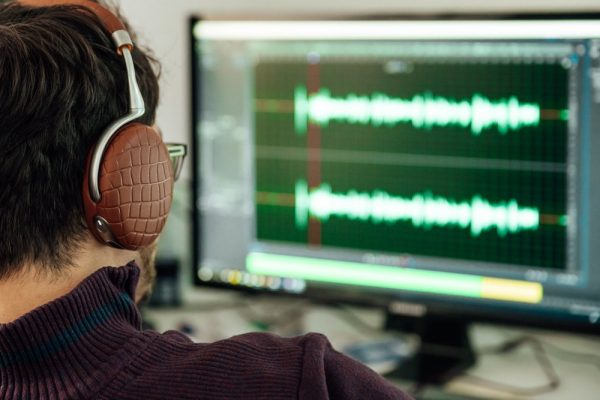No matter how good the content you’ve got lined up for your podcast is, if you don’t record and run it through some editing software before publishing it for your audience, it just won’t have that professional finish.
Editing each episode of your podcast isn’t only about cutting sections, though. The audio may need to be adjusted while you record to give it a more conversational tone, or sound effects may need to be brought in afterward to help break up sections.
Luckily, many software programs can help you do that. And, two of the most popular amongst podcasters are Adobe Audition and Audacity. But which is the better of the two?
We decided to find out in an Adobe Audition VS. Audacity battle, breaking down each of their features and specifications. In the end, we’ll find out, once and for all, which of the two is the best podcast-editing tool.

Table of Contents
Design
The first thing to note is that, although both Adobe Audition and Audacity are similar in terms of what they do, their appearance couldn’t be different.
Adobe Audition has a slick, modern look to it, while Audacity does look a little more dated. And, while you might think that looks don’t matter that much as long as they perform well, each of their interfaces would be better suited to different skill levels.
If you’re fairly computer-literate and it doesn’t take you very long to find your way around a new piece of software, you should be fine with the stylish, hi-tech design of Adobe Audition.
However, if you’re a bit of a technophobe or want something easier to navigate, Audacity’s simplistic design might better suit your needs.
Ease of Use
With each having a very different design, exactly how easy are they to use? Audacity comes up as the winner here. Getting started is as easy as opening the software and hitting record.
There are also easy to navigate, simplistic drop-down menus on the main window that allow you to select each microphone and the headphones you’d like to listen with.
You can also easily choose whether you’d like to record in stereo or mono with a simple click of your mouse. There are even sliders that allow you to adjust and set your recording and playback levels, as well as level monitors so you can monitor your signals.
Adobe Audition is a little more difficult to use. Selecting microphones and adjusting levels isn’t nearly as easy to do as it is with Audacity, and you need to navigate through “Audio Hardware” and “Preferences” settings to do it.
Multitracking
Both Adobe Audition and Audacity have multitracking capabilities. However, each one works a little differently.
As you stop and start between recordings, Audacity will create a new track underneath the previous recording. These can then be stitched together in the editing process, and creating multiple tracks in this way also allows you to insert a pre-existing file into your episode.
Adobe Audition gives you a little more choice. It can either record across one audio file at a time, instead of creating multiple tracks each time you hit the record button, or you can switch to multitracking if you prefer. This can be done by selecting the “Multitrack” option in the toolbar.
By giving you these options, you’ll be able to record with several microphones onto individual tracks simultaneously.
So, if there’s any background noise being picked up by one microphone (or somebody says something you’d rather didn’t appear on your podcast!), you’ll be able to edit them out without having to sacrifice a large section of your recording.
But which piece of software comes up as the winner for its multitracking performance? We’d have to go with Adobe Audition here. You’re offered more options and can edit with greater detail.
Having said that, Audacity’s multitrack feature is undoubtedly easy to navigate and still offers great performance for basic piecing together.

Editing & Mixing
We’ll cut straight to the chase and say that Adobe Audition is the better of the two when it comes to editing and mixing each episode of your podcast. This is especially true if you’re working with multiple audio files.
The editing tools available to you include splitting, cutting, overlapping, and stretching. You’re also able to move clips around in a more intuitive way with Adobe Audition, and it’s easier to work in a non-destructive manner. This means that any edits you make won’t affect the original recording.
With Audacity, working in a non-destructive manner is much harder. So, if you were to edit something out accidentally, it will make the changes to your source material and, ultimately, be the final recording you’re stuck with.
This can be avoided by creating copies of files within Audacity before you start editing, but that’s something that can take a little time and isn’t particularly productive if you’re in a rush to publish your podcast.
EQ
Equalization (or ‘EQ’) allows you to raise and lower the frequency of your audio. Both Adobe Audition and Audacity have this function, and they are both displayed similarly – as a mixing desk.
Both use sliders to adjust each individual ‘ band’s frequency,’ and both offer the same performance removing plosives from your recording.
Accessing the EQ settings between them is a little different, although both are easy to find. With Audacity, you need to head to the “Graphic” option, and with Adobe Audition, you need to select “Graphic Equalizer.”
But, apart from navigation, are there any other differences between the two when looking at EQ? The only thing to note really is that Adobe Audition has more preset settings you can try out before applying to your recording.
Audacity also has a few presets, but these are more geared towards telephone or radio effects.
Limiting & Normalization
If there is one thing that both Adobe Audition and Audacity have in common, it’s their limiting and normalization function. This is practically identical between the two, and with these, you’re offered the ability to control your audio recording’s volume levels and waveform easily.
The only difference is their location within the software. Adobe Audition’s limiting and normalization settings can be found in the “Amplitude and Compression” menu. Audacity is located under “Limiter” and then through the “Hard Limit.”
Noise Reduction
The noise reduction tools (which you’d use to remove ambient noise from your recording) are also fairly similar between Adobe Audition and Audacity. However, as the more advanced of the two, Adobe Audition does offer one thing that Audacity doesn’t.
This is the ability to apply an effect called “Adaptive Noise Reduction.” This clever feature learns background noise as it’s played in multitrack and automatically removes it, rather than relying on a pre-selected sample.
If you’re a beginner to audio-editing, however, you may find Audacity easier to use. While it won’t work as intuitively as Adobe Audition, you’ll still be able to achieve great noise reduction results.
Saving Work
Saving your edited work with both programs is super easy, and it follows the standard “Save” and “Save As” approach. However, the name of your saved files is different, with Audacity referring to them as a “project” and Adobe Audition calling them a “Session.”
It’s worth noting that Adobe Audition’s “Sessions” take up a lot less room than Audacity’s “Projects.” This is because they are saved as a folder that contains everything as a whole, whereas Audacity will create a “Project File” first and then a separate folder that contains all of the data.
Exporting
Exporting your audio files as an MP3 is quick and easy with both. However, as a recurring theme, there are some differences between the two. The easiest export is offered by Adobe Audition, as you need to select a bitrate, name your file, and then export it.
Audacity is open-source. There are a couple of extra steps you need to take before you export due to licensing issues. You’ll need to download and install a LAME encoder as an additional program. However, once that’s done, exporting is super easy.
With this in mind, if you’re looking for the quickest and easiest way to export your files, Adobe Audition would be the best option.
Price
By now, you probably think that Adobe Audition is the better of the two. There is one downside to it, though – the price. Audacity is open-source software, and, as such, it’s free for anybody to download and use.
Adobe Audition comes with a monthly subscription cost of $49.99. This price is the reduced rate you’ll get if you commit to a whole year; otherwise, you’ll be paying $74.99 per month!
This is something that you’ll definitely need to keep in mind, particularly if you’re new to podcasting and haven’t got any ad-revenue coming in yet.
Even if you’re an established podcaster, you simply might find that Audacity works just as well for you as Adobe Audition would, without coming with any extra cost.
Conclusion
As you can see, both Adobe Audition and Audacity are powerful editing tools that should be considered by any podcaster wanting to give their show that professional finish.
There are similarities and differences between both, and, generally speaking, it’s Adobe Audition that comes out on top as the most feature-packed.
This doesn’t necessarily mean it’s easier to use, though. If you’re looking for something that simple to navigate and can still produce high-quality audio, Audacity could be the best choice.
It’s also free to download and use, unlike Adobe Audition, which comes with a monthly subscription fee.
